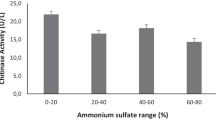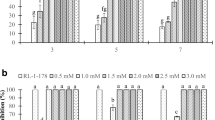Abstract
The ascomycete fungus Mycosphaerella fijiensis causes black Sigatoka disease of banana. Because Serratia marcescens strain CFFSUR-B2 is an effective agent for the biological control of M. fijiensis, it was important to determine the mechanisms by which this bacterium stops or inhibits infection by this phytopathogen. The individual chitinases were effective in reducing germ tube growth to different degrees. We evaluated also the effect of mixtures of purified chitinases (ChiA, ChiB and ChiC) and prodigiosin on the germination and germ tube growth of M. fijiensis ascospores. None of the combinations inhibited ascospore germination. However, a toxic effect similar to that of benzimidazole was observed on ascospore germination by the synergistic action of chitinases and prodigiosin applied in combination. The maximal effect in inhibiting germ tube development observed with a mixture of the chitinases and prodigiosin suggests that these could be used in the effective biocontrol of black Sigatoka disease.



Similar content being viewed by others
Explore related subjects
Discover the latest articles and news from researchers in related subjects, suggested using machine learning.References
Akutsu K, Hirata H, Yamamoto M, Hirayae K, Okuyama S, Hibi T (1993) Growth inhibition of Botrytis spp by Serratia marcescens B2 isolated from tomato phylloplane. Ann Phytopathol Soc Jpn 59:18–25
Asano S, Ogiwara K, Nakagawa Y, Suzuki K, Hori H, Watanabe T (1999) Prodigiosin produced by Serratia marcescens enhances the insecticidal activity of Bacillus thuringiensis delta-endotoxin (CrylC) against common cutworm, Spodoptera litura. J Pestic Sci 24:381–385
Berger RL, Reynolds DM (1988) Colloidal chitin preparation. Methods Enzymol 161:140–142
Brurberg MB, Nes IF, Eijsink VGH (1996) Comparative studies of chitinases A and B from Serratia marcescens. Microbiol 142:1581–1589
Cang S, Sanada M, Johdo O, Ohta S, Nagamatsu Y, Yoshimoto A (2000) High production of prodigiosin by Serratia marcescens grown on ethanol. Biotechnol Lett 22:1761–1765
Chin KM, Kueng FR, Laird D (2000) Aspects of fungicide cross-resistance and implications for strobilurins. Brighton Crop Prot Conf Pests Dis 1:415–420
Davidse LC (1981) Mechanism of action of metalaxyl in Phytophthora megasperma f. sp. medicaginis. Neth J Plant Pathol 87:254–255
Duzhak AB, Panfilova ZI, Duzhak TG (2012) Role of prodigiosin and chitinases in antagonistic activity of the bacterium Serratia marcescens against the fungus Didymella applanata. Biochem (Mosc) 77:910–916
Eckert MR, Rossall S, Selley A, Fitt BDL (2010) Effects of fungicides on in vitro spore germination and mycelial growth of the phytopathogens Leptosphaeria maculans and L. biglobosa (phoma stem canker of oilseed rape). Pest Manag Sci 66:396–405
Fouré E (1985) Black leaf streak disease of bananas and plantains (Mycophaerella fijiensis Morelet), study of the symptoms and stages of the disease in Gabon. Irfa, Paris, France
Fuchs RL, McPherson SA, Drahos DJ (1986) Cloning of a Serratia marcescens gene encoding chitinase. Appl Environ Microbiol 51:504–509
Gerber NN (1975) Prodigiosin-like pigments. CRC Crit Rev Microbiol 3:469–485
Grimont F, Grimont PAD (2006) The genus Serratia. Prokaryotes 6:219–244
Gutiérrez-Román MI, Holguín-Meléndez F, Bello-Mendoza R, Guillén-Navarro K, Dunn MF, Huerta-Palacios G (2012) Production of prodigiosin and chitinases by tropical Serratia marcescens strains with potential to control plant pathogens. World J Microbiol Biotechnol 28:145–153
Gutiérrez-Román MI, Dunn MF, Tinoco-Valencia R, Holguín-Meléndez F, Huerta-Palacios G, Guillen-Navarro K (2014) Potentiation of the synergistic activities of chitinases ChiA, ChiB and ChiC from Serratia marcescens CFFSUR-B2 by chitobiase (Chb) and chitin binding protein (CBP). World J Microbiol Biotechnol 30:33–42
Han SB, Kim HM, Kim YH, Lee CW, Jang ES, Son KH, Kim SU, Kim YK (1998) T-cell specific immunosuppression by prodigiosin isolated from Serratia marcescens. Int J Immunopharmacol 20:1–13
Jones DR (2000) Sigatoka leaf spot diseases. In: Jones DR (ed) Diseases of banana, abacá and enset. CABI Publishing, Wallingford, UK, pp 79–92
Marín DH, Romero RA, Guzman M, Sutton TB (2003) Black Sigatoka an increasing threat to banana cultivation. Plant Dis 87:208–222
McGrath MT (1996) Increased resistance to triadimefon and to benomyl in Sphaerotheca fuliginea populations following fungicide usage over one season. Plant Dis 80:633–639
Meredith DS, Lawrence JS (1969) Black leaf streak disease of bananas (Mycosphaerella fijiensis): symptoms of disease in Hawaii, and notes on the conidial state of the causal fungus. Trans Br Mycol Soc 52:459–476
Monreal J, Reese E (1969) The chitinase of Serratia marcescens. Can J Microbiol 15:689–696
Mourichon X (1997) Mycosphaerella fijiensis, diversity and possibilities for the early screening of germplasm for resistance. In: Jones, D (ed) The improvement and testing of Musa: a global partnership. First Global conference of the international Musa testing program, La Lima, Honduras, pp 47–53
Okamoto H, Sato Z, Sato M, Koiso Y, Iwasaki S, Isaka M (1998) Identification of antibiotic red pigments of Serratia marcescens F-1-1 a biocontrol agent of damping off of cucumber and antimicrobial activity against other plant pathogens. Ann Phytopathol Soc Jpn 64:294–298
Russell PE (2004) Sensitivity baselines in fungicide resistance research and management. FRAC, Cambridge, UK
Sastoque-Cala L, Mercado-Reyes M, Santiago-Salgado M (2007) Quevedo-Hidalgo and Pedroza-Rodríguez M. Producción de quitinasas extracelulares con una cepa alcalófila halotolerante de Streptomyces sp aislada de residuos de camarón. Revista Mexicana de Ingeniería Química 6:137–146
Schickler H, Haran S, Oppenheim AB, Chet I (1993) Cloned chitinases and their role in biological control of plant pathogenic fungi. In: Muzzarelli RAA (ed) Chitin enzymology. Ancona, Italy, pp 375–382
Someya N, Kataoka N, Komagata T, Hirayae K, Hibi T, Akutsu K (2000) Biological control of cyclamen soilborne diseases by Serratia marcescens strain B2. Plant Dis 84:334–340
Someya N, Nakajima M, Hirayae K, Hibi T, Akutsu K (2001) Synergistic antifungal activity of chitinolytic enzymes and prodigiosin produced by the biocontrol bacterium Serratia marcescens strain B2 against the gray mold pathogen, Botrytis cinerea. J Gen Plant Pathol 67:312–317
Someya N, Nakajima M, Watanabe K, Hibi T, Akutsu K (2003) Influence of bacteria isolated from rice plants and rhizospheres on antibiotic production by the antagonistic bacterium Serratia marcescens strain B2. J Gen Plant Pathol 69:342–347
Suzuki K, Sugawara N, Suzuki M, Uchiyama T, Katouno F, Nikaidou N, Watanabe T (2002) Chitinases A, B, and C1 from Serratia marcescens 2170 produced by recombinant Escherichia coli: enzymatic properties and synergism on chitin degradation. Biosci Biotechnol Biochem 66:1075–1083
StatSoft Inc. (2006) STATISTICA (data analysis software system) version 7. http://www.statsoft.com
Stover RH (1980) Sigatoka leaf spots of bananas and plantains. Plant Dis Rep 64:750–758
Thomson NR, Crow MA, McGowan SJ, Cox A, Salmond GP (2000) Biosynthesis of carbapenem antibiotic and prodigiosin pigment in Serratia is under quorum sensing control. Mol Microbiol 36:539–556
Williams RP, Qadri SMH (1980) The pigment of Serratia. In: von Graevenitz A, Rubin SJ (eds) The genus Serratia. CRC Press Inc., Boca Raton, USA, pp 31–78
Author information
Authors and Affiliations
Corresponding author
Additional information
Handling Editor: Monica Höfte.
Rights and permissions
About this article
Cite this article
Gutiérrez-Román, M.I., Holguín-Meléndez, F., Dunn, M.F. et al. Antifungal activity of Serratia marcescens CFFSUR-B2 purified chitinolytic enzymes and prodigiosin against Mycosphaerella fijiensis, causal agent of black Sigatoka in banana (Musa spp.). BioControl 60, 565–572 (2015). https://doi.org/10.1007/s10526-015-9655-6
Received:
Accepted:
Published:
Issue Date:
DOI: https://doi.org/10.1007/s10526-015-9655-6




